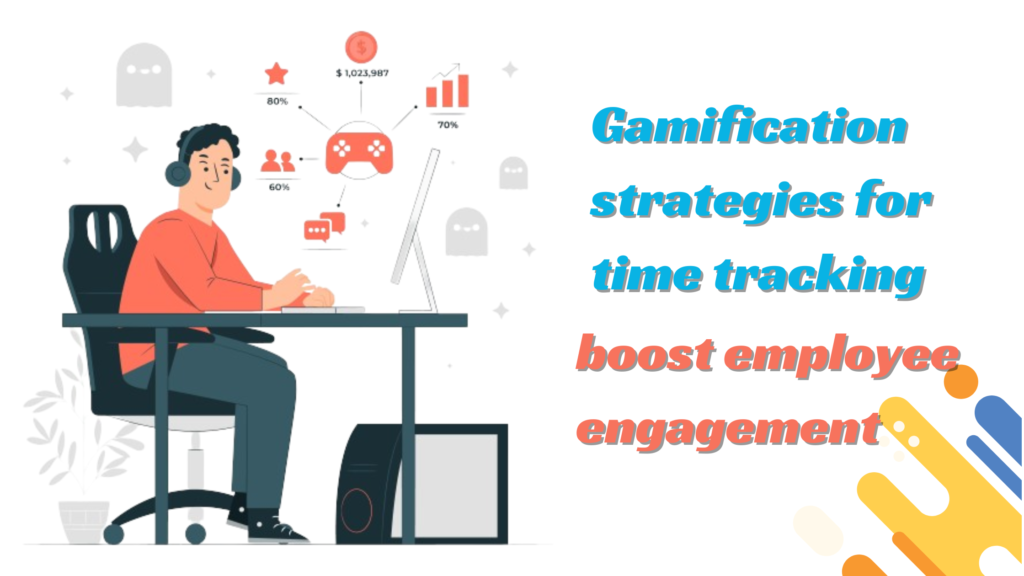- 1 But how is gamification relevant to employees’ time tracking?
- 2 Why gamify time tracking?
- 3 Gamification strategies for time tracking
- 3.1 Points system with clear objectives
- 3.2 Scoreboards with meaningful and practical metrics
- 3.3 Badges and achievements with progressive goals
- 3.4 Progress bars with target setting
- 3.5 Team challenges with collaboration.
- 3.6 Interactive interfaces with user engagement
- 3.7 Rewards and incentives with tangible benefits
- 3.8 Narrative elements with immersive storytelling
Even though time tracking remote employees is all good, considering all its benefits, the process can sometimes be tedious. Let’s be honest about it. Don’t you get that nagging feeling when consistently monitored along with those time spreadsheets? Nonetheless, there are ways to make time tracking fun and engaging by including gamification strategies.
But how is gamification relevant to employees’ time tracking?
So, what exactly is gamification, and how does it relate to time tracking? Gamification is the application of game design elements to non-game contexts. Time tracking involves incorporating points, badges, leaderboards, and healthy competition. This approach can transform the mundane task of time tracking into a captivating experience that boosts employee engagement.
This blog will explore the power of gamification in time-tracking apps for employees, detailing strategies to transform and act as a driver of productivity and positive work culture.
Why gamify time tracking?
Before diving into specific strategies, let’s see why gamification is a practical approach to improving time tracking:
- Increased engagement: One key benefit of gamification is that it injects fun and competition into typically continually boring tasks or activities. This addition can significantly increase employee engagement, making them more enthusiastic about completing their time-tracking responsibilities.
- Motivation: Gamification motivates employees to track their time diligently by introducing rewards and recognition, leading to more accurate data and improved productivity.
- Sense of achievement: Achieving the desired results/goals, levelling up, or earning recognition through gamification creates a sense of pride and accomplishment, driving employees to continue engaging with the time-tracking process.
- Healthy competition: Friendly competition among team members can spur productivity and encourage everyone to stay on track with their time management.
Gamification strategies for time tracking
Now that you understand why the gamification approach to the time-tracking app for employees is an effective solution for increased employee engagement let’s move ahead and learn how its strategies can be applied.
Points system with clear objectives
- Establish a clear set of objectives for time tracking, such as accuracy, consistency, and completion of tasks.
- Assign points to each objective based on its importance to the organization.
- Create a transparent system where employees can track their points and understand how they correlate with their performance.
Scoreboards with meaningful and practical metrics
- Develop leaderboards/scoreboards that display top employee performers and performance metrics related to time tracking, such as accuracy rate and adherence to project or task deadlines.
- Ensure that the scoreboard is updated regularly to maintain interest and provide real-time feedback to employees.
Badges and achievements with progressive goals
- Design badges and achievements that represent milestones in time tracking, like reaching a certain number of consecutive days of accurate tracking or completing a project ahead of schedule.
- Create a progression system where employees can unlock higher-level badges by consistently improving their time-tracking habits.
Progress bars with target setting
- Utilize progress bars to visually represent employees’ progress towards their time-tracking goals.
- Encourage employees to set their time-tracking targets and provide them with tools to monitor their progress over time.
- Incorporate feedback mechanisms that allow employees to adjust their targets based on their performance and workload.
Team challenges with collaboration.
- Organize team challenges that encourage collaboration and teamwork among employees.
- Set collective goals related to time tracking, such as increasing overall accuracy or completing a certain number of tasks within a specified timeframe.
- Offer rewards for teams that successfully meet or exceed their goals through team challenges. This will promote a sense of achievement and foster camaraderie.
Interactive interfaces with user engagement
- Design time-tracking interfaces that are intuitive, visually appealing, and easy to use.
- Incorporate interactive elements such as gamified tutorials, quizzes, or progress trackers to engage users and enhance their understanding of the time-tracking process.
- Solicit employee feedback to continuously improve the user experience and address pain points or usability issues.
Rewards and incentives with tangible benefits
- Offer a variety of meaningful rewards and incentives to employees, such as monetary bonuses, additional vacation days, or opportunities for professional development.
- Personalize rewards to align with individual preferences and motivations, ensuring maximum impact on employee engagement and satisfaction.
- Recognize and celebrate employees’ achievements publicly to reinforce positive behaviours and encourage others to follow suit.
Narrative elements with immersive storytelling
- Incorporate narrative elements into the time-tracking experience to make it more immersive and engaging.
- Develop a compelling storyline or theme that ties into the organization’s culture, values, or goals.
- Create characters, quests, or challenges that employees can relate to and participate in, adding an element of excitement and adventure to the time-tracking process.
By implementing these comprehensive gamification strategies, organizations can transform the time-tracking app for employees into a more fun, engaging, and practical experience. From point systems to leaderboards and rewards, there are numerous ways to make time tracking more enjoyable for everyone involved. So, if you also want to increase your employees’ engagement at work, utilize these gamification strategies for time monitoring today.
